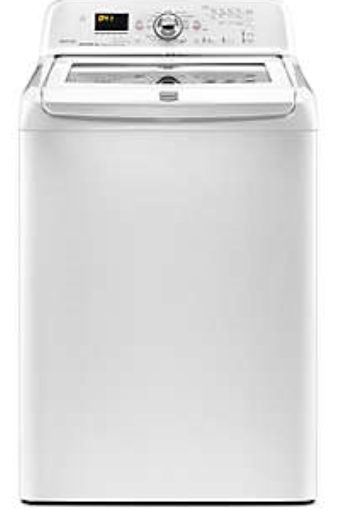Bleach is probably the most effective liquid to use to clean and disinfect any front or top loading washing machine. Even in small amounts, chlorine bleach virtually guarantees the halt of bacterial growths that lead eventually to a smelly washer. So this post covers how to clean a typical washing machine with bleach. Details how to do it safely such that you reduce risks of harm to your clothes, or the washing machine itself.
How to Clean Washing Machine with Bleach Intro
Bleach, coupled with the regular hot water cycle (or the sanitation cycle if your machine has one), is probably about the best you can do to assure a clean washing machine.
Bleach run through a cycle deodorizes and sanitizes as well as loosens and removes most mold and mildew stains from the components inside, including that pesky door seal on front loading machines, and the drum in top loaders. It also retards new buildup of mold for weeks after use. Bleach is cheap, and a single gallon will adequately clean (assuming monthly application) for many moths or even years. Bleach is likely the cheapest yet most effective way to sterilize your washing machine and minimize mold and mildew buildup within.
Cautions and Warnings for How to Clean Washing Machine with Bleach
Heed any Warnings about Bleach in your Washer
If the manufacturer says to avoid bleach, then don’t use it! Indeed, there are many off-the-shelf cleaning products that safely clean this sort of washing machine. Indeed, bleach can damage the valves, hoses, fittings and filters in some models. So, as with all the advice in this blog, the manufacturer’s instructions always supersede any information here.
For Informational Use Only
Apply our suggestions here only after you’ve followed your washing machine maker’s cleaning instructions, and then, always, use at your own risk. We cannot assume any responsibility for damage you may cause to your equipment. Do not ever use chlorine bleach in a front loader unless the manufacturer recommends it.
Provide Enough Ventilation
Avoid using bleach in poorly ventilated spaces. We recommend opening windows or turning on any exhaust fans in your laundry area, as the smell or chlorine can get quite strong when mixed with hot water, as it is when you clean your washer with it using the hot or sanitation cycle.
Don’t Use Too Much Bleach!
Sterilizing your washing machine with bleach is a highly effective, economical way to deodorize it. But too much bleach can damage some machine components and create too strong a chlorine odor. Plus, accidental spilling of bleach can damage floors and clothes as well as irritate the skin. Further, as mentioned, the smell of chlorine can become overbearing during the cycle. So bleach is a last resort for us in keeping our machine sparkling clean and odor free.
But some folks like the strong bleach smell during cleaning, and don’t mind the risks. So for them, we suggest reading the instruction manual for the particular washing machine, to find out if laundering with bleach is okay. If not, then DO NOT use bleach to clean it, which could result in expensive repair bills.
Concentrated Bleach Really Cleans Up that Washing Machine

1. Use More Bleach for Dirtier Washing Machines
For stubborn odors or visible accumulation of smelly dirt and growths on either the tub drum or seals, use a half-cup of bleach to loosen and remove mold and mildew buildup.
2. Wipe Out Any Loose Dirt from the Tub / Drum
If you often wash grimy work clothes and uniforms in your washing machine, the ridges in the tub may accumulate dirt, lint, and so on. If so, wipe away the loose stuff with a damp cloths.
3. Add Bleach
To clean using the machine’s sanitation or clean cycle, drop one quarter cup directly into the tub. Do not put in the soap dispenser though. We also suggest that immediately upon adding the bleach, that you start the washing machine going. Why? Because you don’t want concentrated bleach sitting the washtub for any longer than necessary.
4. Run a Regular Wash Cycle, on Highest Heat with Extra Rinse
Close / latch the door and run the machine on the REGULAR wash cycle, using HOT water. We suggest not using the CLEAN cycle in the bleach case, because extra heated bleach can smell quite strong and take a lot of time to go away. But if you can deal with that strong bleach smell, and you have enough ventilation, then by all means, use the CLEAN cycle.
5. Afterwards, Run the Rinse Again
After the regular wash cycle finishes, run it again through a regular cleaning cycle with just hot water. Add no bleach or detergent this time however. This assures that any last drops of bleach inside rinse away fully. Thus, it will not discolor or otherwise damage your clothing the next time you do laundry.
6. Open Up the Washing Machine and Let it Dry
Once the machine ends the cycle, open the door and let stand overnight to allow faster drying of the tub and door. However, if you plan on washing laundry immediately, you need not wait for the washing machine to dry.
7. Done with How to Clean Washing Machine with Bleach !
Related Posts to How to Clean Washing Machine with Bleach
- How to Clean Door Seal Gasket on Front Loader Washing Machine
- Front Loader Washing Machine Pros and Cons
- Tide Washing Machine Cleaner Review for HE
- Affresh Washer Cleaner Review, for HE Washing Machines
- How to Clean Mold from Front Load Washer Gasket
References for How to Clean Washing Machine with Bleach
- Cleaning Your Washing Machine with Clorox Bleach from CleanMama.net
- How to Sanitize a Front Load Washer from SF Gate
Revision History
- 2021-01-02: First published.
